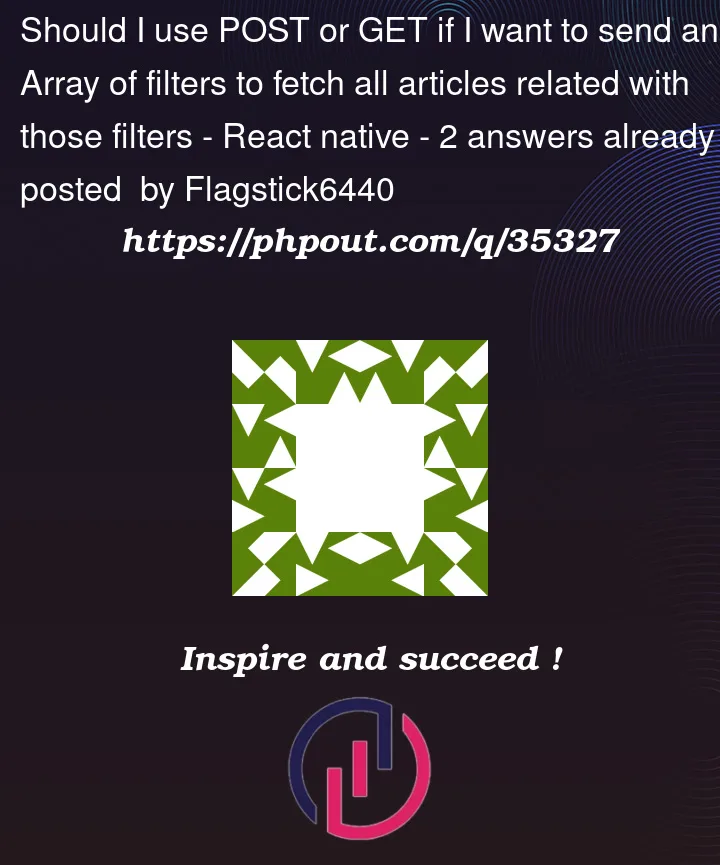I havent find ressources online to solve my problem.
I’m creating an app with React Native that fetches and shows news articles from my database.
At the top of the page, there’s some buttons with filters inside, for example:
one button "energy",
one button "politics"
one button "people"
one button "china"
etc…
Everytime I press one of those buttons, the filter corresponding is stored in an array "selectedFilters", and I want to fetch my database to only show articles that are corresponding to those filters.
Multiple filters can be selected at the same time.
I know one way of doing it, with a POST request:
await fetch('187.345.32.33:3000/fetch-articles', {
method: 'POST',
headers: {'Content-Type':'application/x-www-form-urlencoded'},
body: 'filters=${JSON.stringify(selectedFilters)}'
});
But the fact is, I read everywhere, and I also was teached, that POST request are used when creating or removing, and theoretically, what I should use is a GET request.
But I don’t know how to send an Array with GET request.
I read online that I can pass multiple parameters to my url(for example: arr[0]=selectedFilters[0]&arr[1]=... but the fact is I never know in advance how many items will be in my array.
And also I’m not sure if I could write exactly the same way as my POST request above, but with GET:
await fetch('187.345.32.33:3000/fetch-articles', {
method: 'GET',
headers: {'Content-Type':'application/x-www-form-urlencoded'},
body: 'filters=${JSON.stringify(selectedFilters)}'
});
or if I can only pass items in the url, but does this work ?
await fetch('187.345.32.33:3000/fetch-articles?arr[0]=${selectedFilters[0]', {
Or even better if something like this could work:
await fetch('187.345.32.33:3000/fetch-articles?filters=${JSON.stringify(selectedFilters)}', {
Thanks for your help




2
Answers
You should definitely use a GET request if your purpose is to fetch the data.
One way of passing the array through the URL is by using a map function to create a comma separated string with all the filters. This way you would not need to know in advance how many elements are in the array. The server can then fetch the string from the URL and split it on the commas.
One more method you can try is to save a filters array on the server side for the session. You can then use a POST/PUT request to modify that array with new filter as user adds or remove them. Finally you can use an empty GET request to fetch the news as the server will already have the filters for that session.
Yes, you do read that everywhere. It’s wrong (or at best incomplete).
It may help to remember that on the HTML web, POST was the only supported method for requesting changes to resources, and the web was catastrophically successful.
For requests that are effectively read only, we should prefer to use GET, because general purpose HTTP components can leverage the fact that GET is safe (for example, we can automatically retry a safe request if the response is lost on an unreliable network).
Not quite exactly the same way
The right idea is to think about this in the framing of HTML forms; in HTML, the same collection of input controls can be used with both GET and POST. The difference is what the browser does with the information.
Very roughly, a GET form is used when you want to put the key value pairs described by the submitted form into the query part of the request target. So something roughly like
Although we would normally want to be using a URI Template to generate the request URI, rather than worrying about escaping everything correctly "by hand".
However, there’s no rule that says general purpose HTTP components need to support infinitely long URI (for instance, Internet Explorer used to have a limit just over 2000 characters).
To work around these limits, you might choose to support POST – it’s a tradeoff, you lose the benefits of safe semantics and general purpose cache invalidation, you gain that it works in extreme cases.